Nursing
VerifiedAdded on 2023/04/17
|6
|1341
|279
AI Summary
This document provides information on various topics related to nursing, including ulcerative colitis, sensory neurons and pain, clinical manifestations, and intravenous solutions. It discusses the causes, symptoms, and treatment options for ulcerative colitis, the role of sensory neurons in pain perception, the clinical manifestations of deteriorating health in a patient, and the use of intravenous solutions to restore electrolyte balance. The document includes references for further reading.
Contribute Materials
Your contribution can guide someone’s learning journey. Share your
documents today.
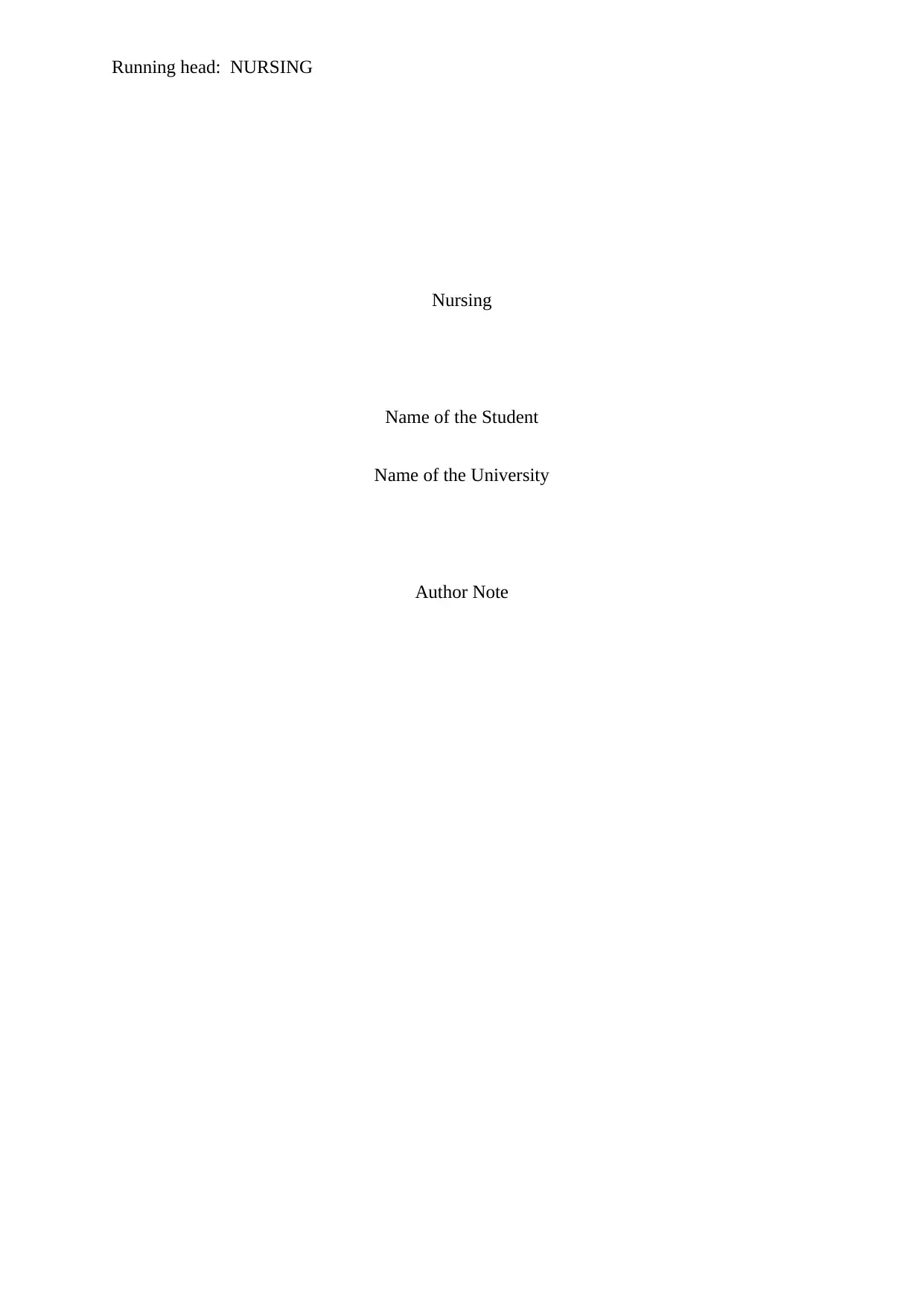
Running head: NURSING
Nursing
Name of the Student
Name of the University
Author Note
Nursing
Name of the Student
Name of the University
Author Note
Secure Best Marks with AI Grader
Need help grading? Try our AI Grader for instant feedback on your assignments.
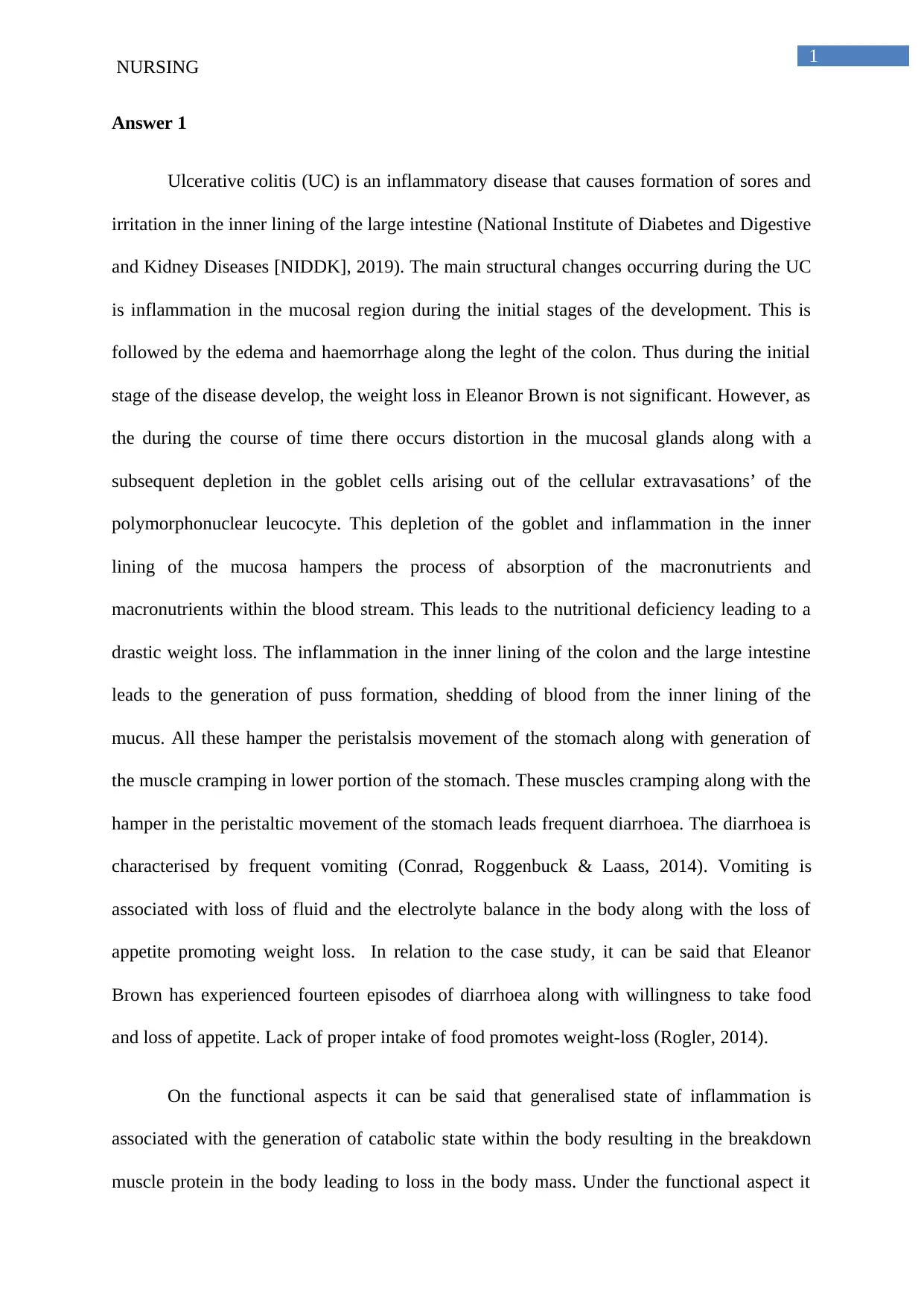
1
NURSING
Answer 1
Ulcerative colitis (UC) is an inflammatory disease that causes formation of sores and
irritation in the inner lining of the large intestine (National Institute of Diabetes and Digestive
and Kidney Diseases [NIDDK], 2019). The main structural changes occurring during the UC
is inflammation in the mucosal region during the initial stages of the development. This is
followed by the edema and haemorrhage along the leght of the colon. Thus during the initial
stage of the disease develop, the weight loss in Eleanor Brown is not significant. However, as
the during the course of time there occurs distortion in the mucosal glands along with a
subsequent depletion in the goblet cells arising out of the cellular extravasations’ of the
polymorphonuclear leucocyte. This depletion of the goblet and inflammation in the inner
lining of the mucosa hampers the process of absorption of the macronutrients and
macronutrients within the blood stream. This leads to the nutritional deficiency leading to a
drastic weight loss. The inflammation in the inner lining of the colon and the large intestine
leads to the generation of puss formation, shedding of blood from the inner lining of the
mucus. All these hamper the peristalsis movement of the stomach along with generation of
the muscle cramping in lower portion of the stomach. These muscles cramping along with the
hamper in the peristaltic movement of the stomach leads frequent diarrhoea. The diarrhoea is
characterised by frequent vomiting (Conrad, Roggenbuck & Laass, 2014). Vomiting is
associated with loss of fluid and the electrolyte balance in the body along with the loss of
appetite promoting weight loss. In relation to the case study, it can be said that Eleanor
Brown has experienced fourteen episodes of diarrhoea along with willingness to take food
and loss of appetite. Lack of proper intake of food promotes weight-loss (Rogler, 2014).
On the functional aspects it can be said that generalised state of inflammation is
associated with the generation of catabolic state within the body resulting in the breakdown
muscle protein in the body leading to loss in the body mass. Under the functional aspect it
NURSING
Answer 1
Ulcerative colitis (UC) is an inflammatory disease that causes formation of sores and
irritation in the inner lining of the large intestine (National Institute of Diabetes and Digestive
and Kidney Diseases [NIDDK], 2019). The main structural changes occurring during the UC
is inflammation in the mucosal region during the initial stages of the development. This is
followed by the edema and haemorrhage along the leght of the colon. Thus during the initial
stage of the disease develop, the weight loss in Eleanor Brown is not significant. However, as
the during the course of time there occurs distortion in the mucosal glands along with a
subsequent depletion in the goblet cells arising out of the cellular extravasations’ of the
polymorphonuclear leucocyte. This depletion of the goblet and inflammation in the inner
lining of the mucosa hampers the process of absorption of the macronutrients and
macronutrients within the blood stream. This leads to the nutritional deficiency leading to a
drastic weight loss. The inflammation in the inner lining of the colon and the large intestine
leads to the generation of puss formation, shedding of blood from the inner lining of the
mucus. All these hamper the peristalsis movement of the stomach along with generation of
the muscle cramping in lower portion of the stomach. These muscles cramping along with the
hamper in the peristaltic movement of the stomach leads frequent diarrhoea. The diarrhoea is
characterised by frequent vomiting (Conrad, Roggenbuck & Laass, 2014). Vomiting is
associated with loss of fluid and the electrolyte balance in the body along with the loss of
appetite promoting weight loss. In relation to the case study, it can be said that Eleanor
Brown has experienced fourteen episodes of diarrhoea along with willingness to take food
and loss of appetite. Lack of proper intake of food promotes weight-loss (Rogler, 2014).
On the functional aspects it can be said that generalised state of inflammation is
associated with the generation of catabolic state within the body resulting in the breakdown
muscle protein in the body leading to loss in the body mass. Under the functional aspect it
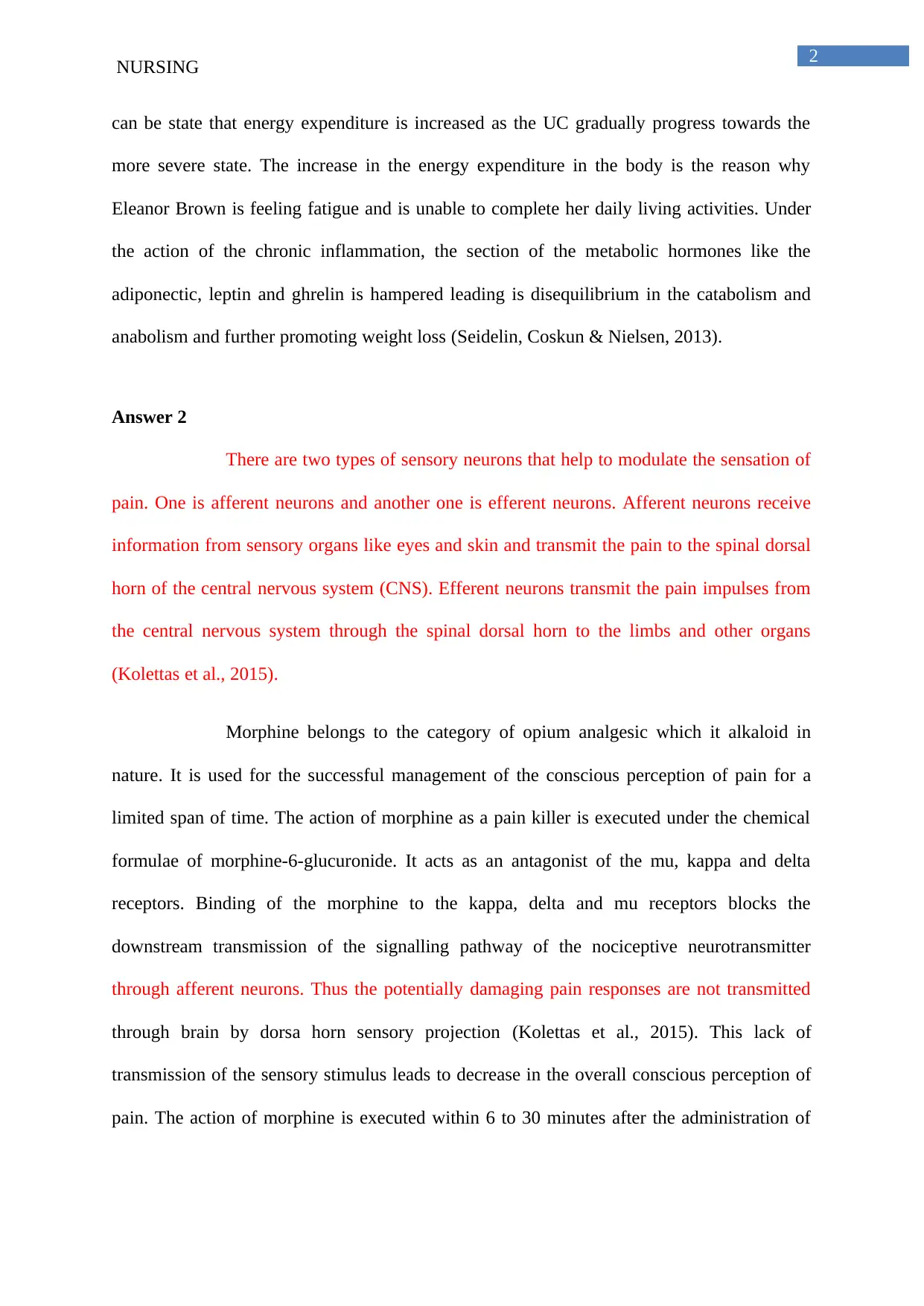
2
NURSING
can be state that energy expenditure is increased as the UC gradually progress towards the
more severe state. The increase in the energy expenditure in the body is the reason why
Eleanor Brown is feeling fatigue and is unable to complete her daily living activities. Under
the action of the chronic inflammation, the section of the metabolic hormones like the
adiponectic, leptin and ghrelin is hampered leading is disequilibrium in the catabolism and
anabolism and further promoting weight loss (Seidelin, Coskun & Nielsen, 2013).
Answer 2
There are two types of sensory neurons that help to modulate the sensation of
pain. One is afferent neurons and another one is efferent neurons. Afferent neurons receive
information from sensory organs like eyes and skin and transmit the pain to the spinal dorsal
horn of the central nervous system (CNS). Efferent neurons transmit the pain impulses from
the central nervous system through the spinal dorsal horn to the limbs and other organs
(Kolettas et al., 2015).
Morphine belongs to the category of opium analgesic which it alkaloid in
nature. It is used for the successful management of the conscious perception of pain for a
limited span of time. The action of morphine as a pain killer is executed under the chemical
formulae of morphine-6-glucuronide. It acts as an antagonist of the mu, kappa and delta
receptors. Binding of the morphine to the kappa, delta and mu receptors blocks the
downstream transmission of the signalling pathway of the nociceptive neurotransmitter
through afferent neurons. Thus the potentially damaging pain responses are not transmitted
through brain by dorsa horn sensory projection (Kolettas et al., 2015). This lack of
transmission of the sensory stimulus leads to decrease in the overall conscious perception of
pain. The action of morphine is executed within 6 to 30 minutes after the administration of
NURSING
can be state that energy expenditure is increased as the UC gradually progress towards the
more severe state. The increase in the energy expenditure in the body is the reason why
Eleanor Brown is feeling fatigue and is unable to complete her daily living activities. Under
the action of the chronic inflammation, the section of the metabolic hormones like the
adiponectic, leptin and ghrelin is hampered leading is disequilibrium in the catabolism and
anabolism and further promoting weight loss (Seidelin, Coskun & Nielsen, 2013).
Answer 2
There are two types of sensory neurons that help to modulate the sensation of
pain. One is afferent neurons and another one is efferent neurons. Afferent neurons receive
information from sensory organs like eyes and skin and transmit the pain to the spinal dorsal
horn of the central nervous system (CNS). Efferent neurons transmit the pain impulses from
the central nervous system through the spinal dorsal horn to the limbs and other organs
(Kolettas et al., 2015).
Morphine belongs to the category of opium analgesic which it alkaloid in
nature. It is used for the successful management of the conscious perception of pain for a
limited span of time. The action of morphine as a pain killer is executed under the chemical
formulae of morphine-6-glucuronide. It acts as an antagonist of the mu, kappa and delta
receptors. Binding of the morphine to the kappa, delta and mu receptors blocks the
downstream transmission of the signalling pathway of the nociceptive neurotransmitter
through afferent neurons. Thus the potentially damaging pain responses are not transmitted
through brain by dorsa horn sensory projection (Kolettas et al., 2015). This lack of
transmission of the sensory stimulus leads to decrease in the overall conscious perception of
pain. The action of morphine is executed within 6 to 30 minutes after the administration of
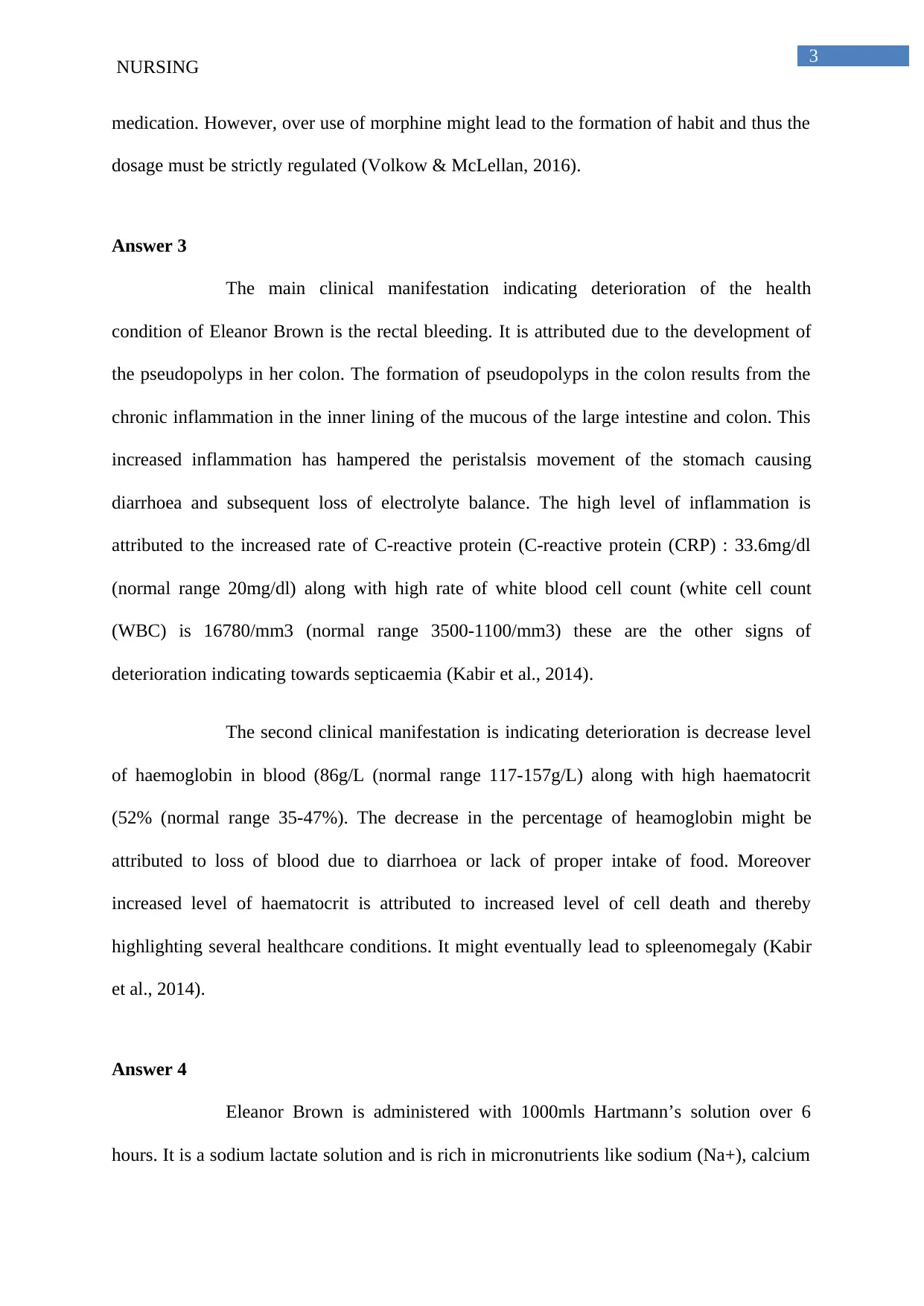
3
NURSING
medication. However, over use of morphine might lead to the formation of habit and thus the
dosage must be strictly regulated (Volkow & McLellan, 2016).
Answer 3
The main clinical manifestation indicating deterioration of the health
condition of Eleanor Brown is the rectal bleeding. It is attributed due to the development of
the pseudopolyps in her colon. The formation of pseudopolyps in the colon results from the
chronic inflammation in the inner lining of the mucous of the large intestine and colon. This
increased inflammation has hampered the peristalsis movement of the stomach causing
diarrhoea and subsequent loss of electrolyte balance. The high level of inflammation is
attributed to the increased rate of C-reactive protein (C-reactive protein (CRP) : 33.6mg/dl
(normal range 20mg/dl) along with high rate of white blood cell count (white cell count
(WBC) is 16780/mm3 (normal range 3500-1100/mm3) these are the other signs of
deterioration indicating towards septicaemia (Kabir et al., 2014).
The second clinical manifestation is indicating deterioration is decrease level
of haemoglobin in blood (86g/L (normal range 117-157g/L) along with high haematocrit
(52% (normal range 35-47%). The decrease in the percentage of heamoglobin might be
attributed to loss of blood due to diarrhoea or lack of proper intake of food. Moreover
increased level of haematocrit is attributed to increased level of cell death and thereby
highlighting several healthcare conditions. It might eventually lead to spleenomegaly (Kabir
et al., 2014).
Answer 4
Eleanor Brown is administered with 1000mls Hartmann’s solution over 6
hours. It is a sodium lactate solution and is rich in micronutrients like sodium (Na+), calcium
NURSING
medication. However, over use of morphine might lead to the formation of habit and thus the
dosage must be strictly regulated (Volkow & McLellan, 2016).
Answer 3
The main clinical manifestation indicating deterioration of the health
condition of Eleanor Brown is the rectal bleeding. It is attributed due to the development of
the pseudopolyps in her colon. The formation of pseudopolyps in the colon results from the
chronic inflammation in the inner lining of the mucous of the large intestine and colon. This
increased inflammation has hampered the peristalsis movement of the stomach causing
diarrhoea and subsequent loss of electrolyte balance. The high level of inflammation is
attributed to the increased rate of C-reactive protein (C-reactive protein (CRP) : 33.6mg/dl
(normal range 20mg/dl) along with high rate of white blood cell count (white cell count
(WBC) is 16780/mm3 (normal range 3500-1100/mm3) these are the other signs of
deterioration indicating towards septicaemia (Kabir et al., 2014).
The second clinical manifestation is indicating deterioration is decrease level
of haemoglobin in blood (86g/L (normal range 117-157g/L) along with high haematocrit
(52% (normal range 35-47%). The decrease in the percentage of heamoglobin might be
attributed to loss of blood due to diarrhoea or lack of proper intake of food. Moreover
increased level of haematocrit is attributed to increased level of cell death and thereby
highlighting several healthcare conditions. It might eventually lead to spleenomegaly (Kabir
et al., 2014).
Answer 4
Eleanor Brown is administered with 1000mls Hartmann’s solution over 6
hours. It is a sodium lactate solution and is rich in micronutrients like sodium (Na+), calcium
Secure Best Marks with AI Grader
Need help grading? Try our AI Grader for instant feedback on your assignments.
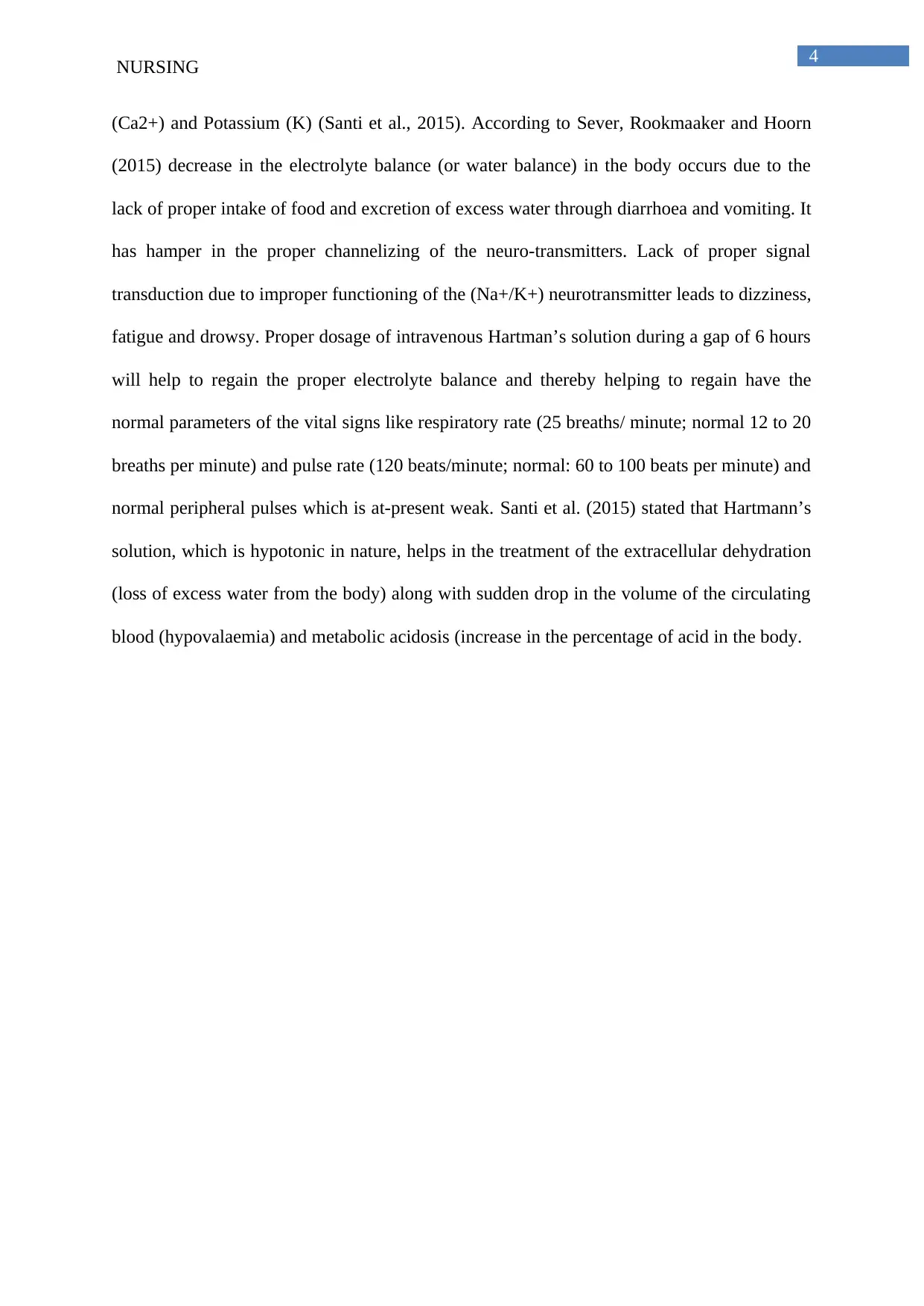
4
NURSING
(Ca2+) and Potassium (K) (Santi et al., 2015). According to Sever, Rookmaaker and Hoorn
(2015) decrease in the electrolyte balance (or water balance) in the body occurs due to the
lack of proper intake of food and excretion of excess water through diarrhoea and vomiting. It
has hamper in the proper channelizing of the neuro-transmitters. Lack of proper signal
transduction due to improper functioning of the (Na+/K+) neurotransmitter leads to dizziness,
fatigue and drowsy. Proper dosage of intravenous Hartman’s solution during a gap of 6 hours
will help to regain the proper electrolyte balance and thereby helping to regain have the
normal parameters of the vital signs like respiratory rate (25 breaths/ minute; normal 12 to 20
breaths per minute) and pulse rate (120 beats/minute; normal: 60 to 100 beats per minute) and
normal peripheral pulses which is at-present weak. Santi et al. (2015) stated that Hartmann’s
solution, which is hypotonic in nature, helps in the treatment of the extracellular dehydration
(loss of excess water from the body) along with sudden drop in the volume of the circulating
blood (hypovalaemia) and metabolic acidosis (increase in the percentage of acid in the body.
NURSING
(Ca2+) and Potassium (K) (Santi et al., 2015). According to Sever, Rookmaaker and Hoorn
(2015) decrease in the electrolyte balance (or water balance) in the body occurs due to the
lack of proper intake of food and excretion of excess water through diarrhoea and vomiting. It
has hamper in the proper channelizing of the neuro-transmitters. Lack of proper signal
transduction due to improper functioning of the (Na+/K+) neurotransmitter leads to dizziness,
fatigue and drowsy. Proper dosage of intravenous Hartman’s solution during a gap of 6 hours
will help to regain the proper electrolyte balance and thereby helping to regain have the
normal parameters of the vital signs like respiratory rate (25 breaths/ minute; normal 12 to 20
breaths per minute) and pulse rate (120 beats/minute; normal: 60 to 100 beats per minute) and
normal peripheral pulses which is at-present weak. Santi et al. (2015) stated that Hartmann’s
solution, which is hypotonic in nature, helps in the treatment of the extracellular dehydration
(loss of excess water from the body) along with sudden drop in the volume of the circulating
blood (hypovalaemia) and metabolic acidosis (increase in the percentage of acid in the body.
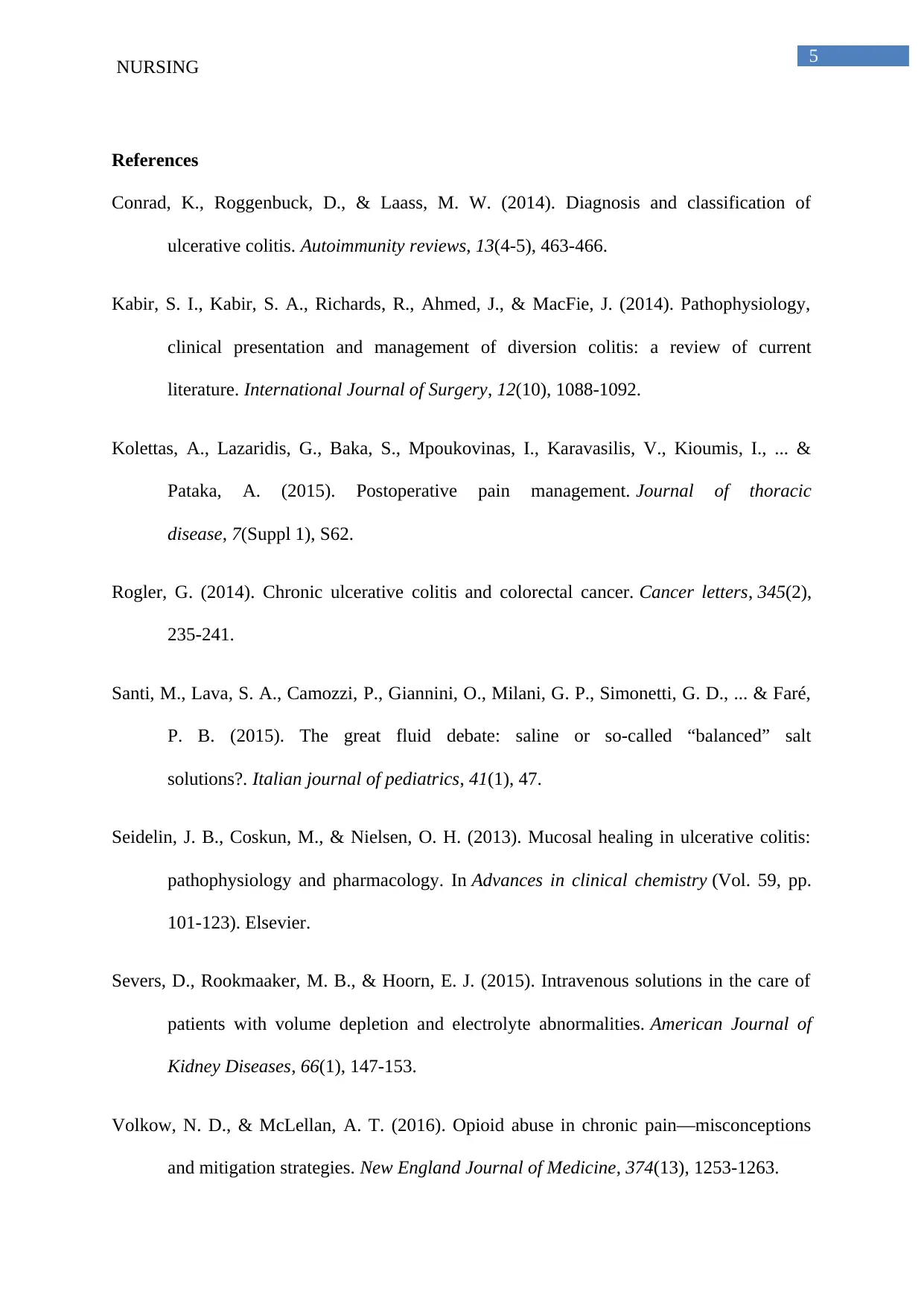
5
NURSING
References
Conrad, K., Roggenbuck, D., & Laass, M. W. (2014). Diagnosis and classification of
ulcerative colitis. Autoimmunity reviews, 13(4-5), 463-466.
Kabir, S. I., Kabir, S. A., Richards, R., Ahmed, J., & MacFie, J. (2014). Pathophysiology,
clinical presentation and management of diversion colitis: a review of current
literature. International Journal of Surgery, 12(10), 1088-1092.
Kolettas, A., Lazaridis, G., Baka, S., Mpoukovinas, I., Karavasilis, V., Kioumis, I., ... &
Pataka, A. (2015). Postoperative pain management. Journal of thoracic
disease, 7(Suppl 1), S62.
Rogler, G. (2014). Chronic ulcerative colitis and colorectal cancer. Cancer letters, 345(2),
235-241.
Santi, M., Lava, S. A., Camozzi, P., Giannini, O., Milani, G. P., Simonetti, G. D., ... & Faré,
P. B. (2015). The great fluid debate: saline or so-called “balanced” salt
solutions?. Italian journal of pediatrics, 41(1), 47.
Seidelin, J. B., Coskun, M., & Nielsen, O. H. (2013). Mucosal healing in ulcerative colitis:
pathophysiology and pharmacology. In Advances in clinical chemistry (Vol. 59, pp.
101-123). Elsevier.
Severs, D., Rookmaaker, M. B., & Hoorn, E. J. (2015). Intravenous solutions in the care of
patients with volume depletion and electrolyte abnormalities. American Journal of
Kidney Diseases, 66(1), 147-153.
Volkow, N. D., & McLellan, A. T. (2016). Opioid abuse in chronic pain—misconceptions
and mitigation strategies. New England Journal of Medicine, 374(13), 1253-1263.
NURSING
References
Conrad, K., Roggenbuck, D., & Laass, M. W. (2014). Diagnosis and classification of
ulcerative colitis. Autoimmunity reviews, 13(4-5), 463-466.
Kabir, S. I., Kabir, S. A., Richards, R., Ahmed, J., & MacFie, J. (2014). Pathophysiology,
clinical presentation and management of diversion colitis: a review of current
literature. International Journal of Surgery, 12(10), 1088-1092.
Kolettas, A., Lazaridis, G., Baka, S., Mpoukovinas, I., Karavasilis, V., Kioumis, I., ... &
Pataka, A. (2015). Postoperative pain management. Journal of thoracic
disease, 7(Suppl 1), S62.
Rogler, G. (2014). Chronic ulcerative colitis and colorectal cancer. Cancer letters, 345(2),
235-241.
Santi, M., Lava, S. A., Camozzi, P., Giannini, O., Milani, G. P., Simonetti, G. D., ... & Faré,
P. B. (2015). The great fluid debate: saline or so-called “balanced” salt
solutions?. Italian journal of pediatrics, 41(1), 47.
Seidelin, J. B., Coskun, M., & Nielsen, O. H. (2013). Mucosal healing in ulcerative colitis:
pathophysiology and pharmacology. In Advances in clinical chemistry (Vol. 59, pp.
101-123). Elsevier.
Severs, D., Rookmaaker, M. B., & Hoorn, E. J. (2015). Intravenous solutions in the care of
patients with volume depletion and electrolyte abnormalities. American Journal of
Kidney Diseases, 66(1), 147-153.
Volkow, N. D., & McLellan, A. T. (2016). Opioid abuse in chronic pain—misconceptions
and mitigation strategies. New England Journal of Medicine, 374(13), 1253-1263.
1 out of 6
Related Documents
Your All-in-One AI-Powered Toolkit for Academic Success.
+13062052269
info@desklib.com
Available 24*7 on WhatsApp / Email
![[object Object]](/_next/static/media/star-bottom.7253800d.svg)
Unlock your academic potential
© 2024 | Zucol Services PVT LTD | All rights reserved.





